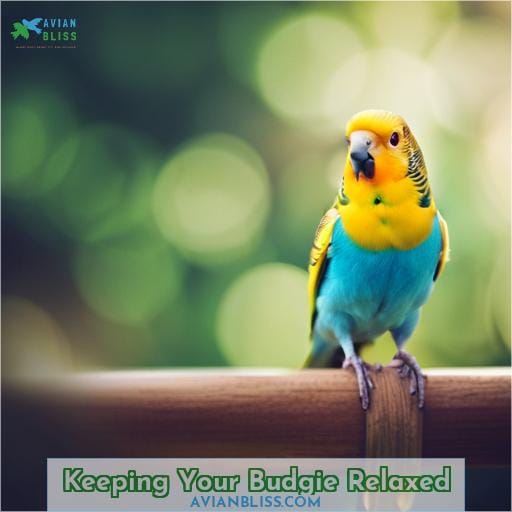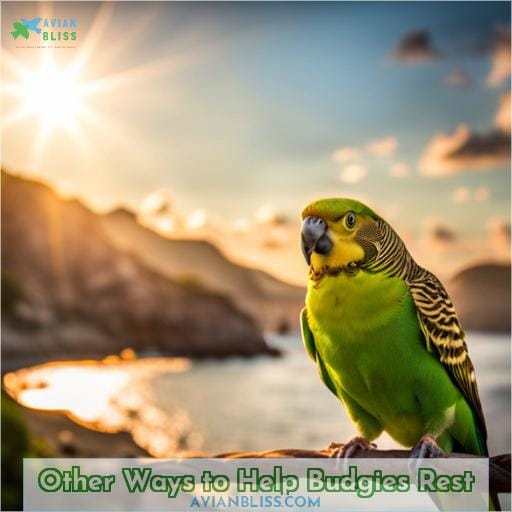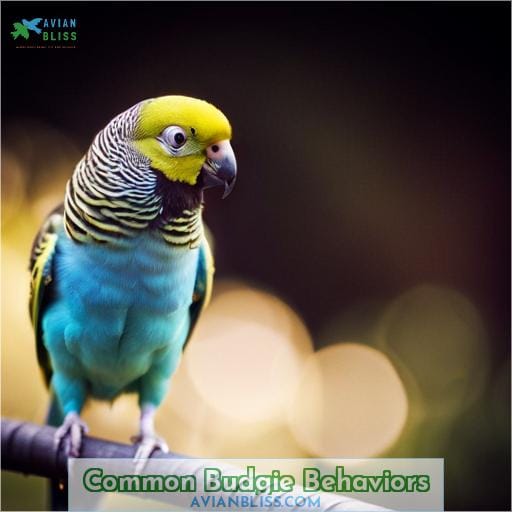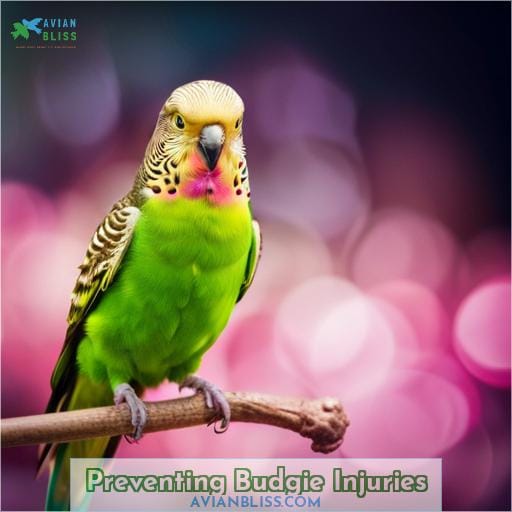This site is supported by our readers. We may earn a commission, at no cost to you, if you purchase through links.
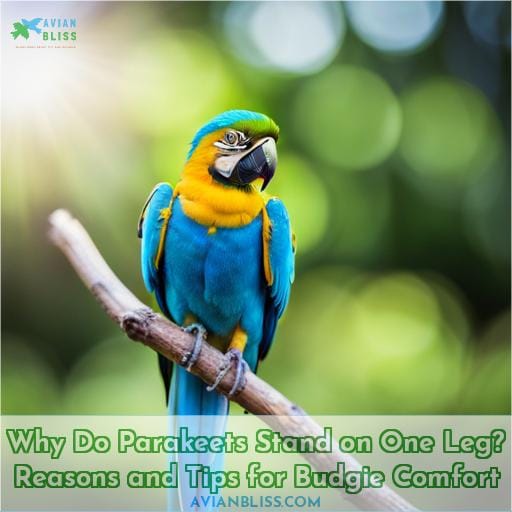 You’re wondering why your parakeet stands on one foot? It’s totally normal budgie behavior.
You’re wondering why your parakeet stands on one foot? It’s totally normal budgie behavior.
They stand on one leg to rest their feet and keep warm.
Perch size and texture matters – proper perches aid grip and comfort.
Keep your little buddy’s environment relaxing and provide various perches.
With understanding and tips for budgie comfort, you’ll see one-legged stances just mean a content companion.
Table Of Contents
Key Takeaways
- Parakeets stand on one foot for various reasons such as resting, keeping warm, and exercising their feet.
- Standing on one foot is a common behavior in happy and relaxed parakeets.
- Providing a comfortable and safe environment, along with plenty of perches and toys, can help keep parakeets relaxed.
- Regular foot soaks and prompt treatment of infections are important for maintaining the health of parakeets.
Reasons for Standing on One Foot
As an avian expert, I can share that parakeets commonly stand on one leg to rest, keep warm, and exercise their feet.
By standing on one leg, they reduce fatigue and conserve body heat while still getting the benefits of balancing exercises.
Now let’s explore these reasons and tips for supporting your budgie’s comfort in more detail.
Resting
When budgies stand on one foot, it’s often a sign that they’re taking a moment to rest and relax.
This behavior allows them to keep their balance while giving their other foot a break.
Standing on one leg also helps to improve balance and conserve heat in their bodies.
Plus, it keeps their feet clean and prevents injuries.
So next time you see your budgie standing on one leg, know that they’re just finding comfort in the simplest of positions!
Keeping Warm
Budgies stand on one leg to help conserve heat.
- Exposes more body to air, helping circulate heat.
- Prevents feet from getting cold.
- Keeps body temperature regulated.
- Helps prevent hypothermia.
Exercising Feet
Get your budgie’s feet moving and healthy by encouraging them to exercise their feet through standing on one leg.
This behavior helps with balance, reduces muscle fatigue, keeps the feet clean, and keeps them healthy.
So next time you see your little feathered friend perched on one foot, know that they’re just giving their little toes a workout while finding relaxation at the same time.
Choosing Proper Perches
When choosing perches for your budgie, it’s essential to consider the following:
- The diameter of the perch should match the width of your budgie’s foot to prevent slipping and falling.
- A rough or textured texture will aid in gripping the perch and promoting foot health.
- Opt for natural materials like wood or bamboo that mimic your budgie’s natural environment and ensure they’re free from any toxic substances that could harm them.
Perch Diameter Matters
To ensure your budgie’s comfort, it’s important to choose perches with the right diameter.
The perch should be about the same width as your budgie’s foot, and it should be made of a natural material, such as wood or bamboo.
Texture Aids Grip
A perch with a rough or textured surface will help your budgie grip better.
Smooth perches can hurt their feet, so make sure to provide your budgie with perches that are textured.
Natural Materials Best
Natural materials are best for perches because they mimic your budgie’s natural environment and provide a comfortable grip.
- Wood perches
- Bamboo perches
- Natural rope perches
- Sandpaper perches
- Lava perches
Keeping Your Budgie Relaxed
There are a few things you can do to help keep your budgie relaxed, including providing a comfortable, quiet, and safe environment.
Budgies feel most at ease when they’re in a secure space free from any potential dangers or disturbances.
Make sure their cage is located in a peaceful area of your home where they won’t be bothered by loud noises or sudden movements.
Offering plenty of perches and toys will also provide stimulation for them to stay entertained and engaged.
Additionally, keeping the cage clean is important as dirtiness can cause stress for budgies.
If necessary, give your budgie foot soaks to soothe their feet and promote circulation.
Lastly, make sure to promptly treat any infections that may arise as these can lead to discomfort or other health issues.
Other Ways to Help Budgies Rest
If you want to help your budgie relax and get a good rest, you can try a few other methods.
- Give your budgie a foot soak. Soaking their feet in warm water for a few minutes can soothe their feet and promote circulation.
- Treat any infections promptly. If your budgie has any infections, such as bumblefoot, it’s important to seek veterinary treatment right away.
- Provide plenty of stimulation. Budgies are curious and intelligent creatures that need mental stimulation to stay happy and healthy. Offer them toys that encourage playtime or spend time interacting with them directly.
- Avoid drafts in the environment where they rest or sleep. Drafts can make the temperature uncomfortable for budgies which may lead to stress or illness.
- Offer different types of perches in their cage for variety and comfort.
By incorporating these methods into your care routine, you’ll be helping your feathered friend find relaxation while ensuring their overall well-being.
Common Budgie Behaviors
One common behavior that budgies exhibit is perching on one leg. Although it may seem strange to us, this behavior serves a purpose for these little feathered friends.
When you see your budgie standing on one leg, it could be an indication that they’re feeling comfortable and at ease in their environment.
Budgies also engage in other behaviors such as:
- Chirping melodiously
- Grinding their beaks to keep them trim and healthy
- Flapping their wings with joyous abandon
- Preening each individual feather meticulously to maintain cleanliness and beauty (they do love looking good!)
- Playing enthusiastically with toys designed for mental stimulation and physical exercise.
These playful antics not only provide entertainment but also contribute to the overall well-being of your beloved budgie companion.
Preventing Budgie Injuries
To prevent budgie injuries, keep the cage clean and free of sharp objects.
Budgies are curious creatures that love to explore their surroundings, but they can easily injure themselves on sharp edges or protruding objects in their cage.
Regularly inspect the cage for any potential hazards and remove them promptly.
It’s also important to provide a variety of perches with different sizes and textures to promote foot health and prevent strain or discomfort.
Avoid overweight by providing a balanced diet consisting of fresh fruits, vegetables, seeds, and pellets in appropriate portions.
If you notice any signs of lameness or injury in your budgie’s leg, it’s crucial to see an avian vet for proper diagnosis and treatment options.
Resting the leg may be necessary during recovery period while avoiding giving your bird any pain relievers without veterinary guidance as some medications can be harmful to birds.
Frequently Asked Questions (FAQs)
Why do budgies puff up?
Your budgie puffs up when they’re feeling threatened or scared.
They may also puff up when they’re trying to attract a mate.
Why does my budgie hang upside down?
Your budgie hangs upside down to:
- Stretch its wings
- Exercise its muscles
- Cool down
- Get a better view of its surroundings.
What are the signs of lameness in parakeets?
If your parakeet is limping, favoring one foot, or unable to stand on one foot, it may be lame.
Lameness can be caused by a variety of things, including:
- Tumors
- Injury
- Sprains
- Broken bones
- Frostbite
See an avian vet as soon as possible to determine the cause of the lameness and get treatment.
How can I treat lameness in my parakeet?
To treat lameness in your parakeet, consult an avian vet.
Rest the leg and remove uncomfortable perches.
Avoid giving pain relievers without professional advice.
If there’s no improvement by Monday, visit the vet to check for a broken leg.
How can I prevent lameness in my parakeet?
To prevent lameness in your parakeet:
- Keep their cage clean and free of sharp objects.
- Provide them with a variety of perches of different sizes and shapes.
- Avoid letting them fly into objects.
- Don’t allow them to become overweight.
Conclusion
To sum it up, parakeets stand on one leg for various reasons, including:
- Resting
- Keeping warm
- Exercising their feet.
Choosing proper perches with the right diameter and texture is crucial for their comfort and grip. By providing a relaxing environment and a variety of perches, you can ensure your budgie’s contentment.
Understanding common budgie behaviors and taking steps to prevent injuries will also contribute to their overall well-being.
So, embrace your budgie’s one-legged stance as a sign of a happy and comfortable companion.



